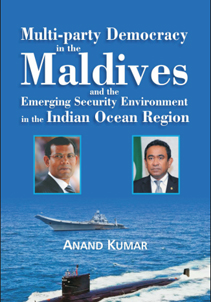Multi-party Democracy in the Maldives and the Emerging Security Environment in the Indian Ocean Region
- 2016 |
- Book

About the Book
Maldives is the smallest country of South Asia. But its significance is no less because of its crucial geo-strategic location in the Indian Ocean. It sits astride on major sea lanes of communications (SLOCs). However, the crucial geo-strategic location of the Maldives has also caused problems for the country as it has aroused interests of major world powers. They have tried to meddle into the domestic politics of the Maldives so that a favourable dispensation can come to power, which in turn would promote their interests in the Maldives and in the Indian Ocean region (IOR). Maldives became a multi-party democracy in October 2008 when a new constitution was implemented. This was a positive development in a hundred percent Sunni Muslim country, as a number of other Muslim countries were moving on the path of extremism. Ironically, the multiparty democracy also allowed rise in extremism as radicals used the available democratic space to their advantage. Unfortunately, the first democratic government in the Maldives could not complete its term and the ensuing political instability in the Maldives led to greater meddling by external powers in its domestic politics.
This book is an attempt to understand the fledgling multiparty democracy in the Maldives, its foreign policy and the evolving security scenario in the Indian Ocean region.
About the Author
Dr. Anand Kumar is an Associate Fellow at the Institute for Defence Studies and Analyses (IDSA), New Delhi. After completing his PhD from School of International Studies, Jawaharlal Nehru Univesity (JNU), he joined the IDSA in 2007. His area of specialization is Maldives, Bangladesh, South Asian politics, Counter-terrorism, Proliferation of Small Arms and Low intensity conflicts. Before joining IDSA he worked at South Asia Analysis Group on similar themes. He has also been with the Institute for Conflict Management which specializes on Counter-terrorism.
His first book Return from the Precipice: Bangladesh’s Fight Against Terrorism was published in year 2012. His edited volume The Terror Challenge in South Asia and Prospect of Regional Cooperation was published in 2011. He has published around 20 articles in reputed journals, contributed around 10 chapters in edited books and delivered lectures on security issues both in India and abroad. He has published hundreds of articles in leading newspapers and magazines. Some of the select publications are “Insurgency in South Asia muted by war on terror,” The Washington Times, January 16, 2004 and The Jihadi Next Door, The Washington Times, 20 May 2010
CONTENTS
Acknowledgements
Map of Maldives
-
- Introduction
Methodology
Organisation
- Introduction
-
- The Road to Multi-party Democracy
Maldives and the British Suzerainty
The First Written Constitution of the Maldives
The Second Constitution
Establishment of First Republican Government with theThird Constitution
The Fourth Constitution Brings Elected Monarchy
Establishment of Second Republic with the Fifth Constitution
Establishment of Constitutional Assembly by Gayoom
The 2008 Constitution
- The Road to Multi-party Democracy
-
- Multi-party Democracy in the Maldives
Presidential Election 2008
Onset of Multi-party Democracy
The 2009 Parliamentary Elections
Emergence of the Political Rivalry
Nasheed Gives up ‘Forgive and Forget’ Policy
Power Struggle between the President and the Parliament
Other Challenges before Nasheed’s Government
A Legacy of Financial Crisis
Economic Crisis Alienated People
Rise of Islamic Fundamentalism
Emergence of Religious Extremism in the Maldives
Gayoom and the Islamic Extremists
Emergence of Extremist OrganisationsInvolvement of Maldivians in Terror Attacks
Islamists in Post-Gayoom Era
Nasheed’s Government Admits Rising Extremism
Extremism Hampered Promotion of Tourism
The Unholy Alliance of Islamists and ‘Democrats’
Nasheed’s Lack of Political Abilities
Mishandling of the Political Crisis by Nasheed
Political Transition or Coup
Fumbling of Indian Diplomacy
Setback to Multi-party Democracy
- Multi-party Democracy in the Maldives
-
- Maldives under Waheed
The GMR Controversy
Indian Approach to Political Crisis in Maldives - The Controversial Second Multi-party Elections
The 2013 Presidential Elections
Use of Institutions to Further Political and Electoral Interests
Breaking-up of the Progressive Alliance and Change of Political Scenario
Islamists under Abdulla Yameen
Yameen’s Suppression of the Opposition and Re-alignment of Political Forces
Future of Multi-party Democracy in the Maldives
- Maldives under Waheed
-
- Changing Regimes and Maldivian Foreign Policy
Maldives and Indian Interests
Foreign Policy of the Maldives after Independence (Since 1965)
Foreign Policy under Gayoom
Foreign Policy under Nasheed
Foreign Policy under Waheed
Foreign Policy under Abdulla Yameen
Implications for India
- Changing Regimes and Maldivian Foreign Policy
-
- Strategic Importance of the Indian Ocean and the Maldives
Maritime Challenges in the IOR
Protection of SLOCs
Piracy
Maritime Terrorism
Security against Mining
Natural Disasters and Oil-related Environmental Disasters
Absence of a Unified Trans-Oceanic Community in the IOR
Strategic Interests of the Major Indian Ocean Players
Indian Interests in the Indian Ocean
India’s Sea Power
The US Interests in the Indian Ocean
Strategic Interests of Australia in the IOR
Japan’s Interests in the Indian Ocean Region (IOR)
China’s Interests and Activities in the Indian Ocean
Emergence of Chinese Maritime Security Interests
China and the Maritime Silk Route
China’s Seabed Mining Forays in the IOR
India’s Attempt to Reinvigorate Policy towards the IOR
Tri-Nation Maritime Agreement
India’s five-fold Framework for Maritime Engagement in the IOR
Maldives and Major Powers
Changing Dynamics of the Indian Ocean Region
- Strategic Importance of the Indian Ocean and the Maldives
-
- Maldives and the Great Game in the Indian Ocean Region
Maldives and Chinese Strategic Considerations
Chinese Quest for Military Bases
Maldives Amends Constitution to Enable Foreign Ownership of Land
Chinese Military Diplomacy with the Maldives
Negotiation of the US-Maldives SOFA Agreement
India Striving to Maintain Security Environment of Indian Ocean
The Emerging Security Scenario in the IOR
- Maldives and the Great Game in the Indian Ocean Region
-
- The Future of Democracy in Maldives and Its Impact on the Security Environment in the Indian Ocean RegionAPPENDICESAppendix 1: Statement by His Excellency Mohamed Nasheed, President of the Republic of Maldives to the General Debate of the General Assembly
Appendix 2: Proposed Agreement between The United States of America and The Republic of Maldives Regarding Status of Forces and Access to and use of Facilities in the Maldives
Appendix 3: Outcome Document of the Second NSA-Level Meeting on Trilateral Cooperation on Maritime Security between India, the Maldives and Sri Lanka
Appendix 4: Maldives
- The Future of Democracy in Maldives and Its Impact on the Security Environment in the Indian Ocean RegionAPPENDICESAppendix 1: Statement by His Excellency Mohamed Nasheed, President of the Republic of Maldives to the General Debate of the General Assembly
Index
Order Hard Copy
Please email us at adps.idsa [at] nic.in or call +91-11-2671 7983 (Ext. 7303)







